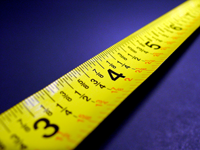Introduction: Connecting Your Learning
 This module discusses the United States System of Measurement. By the end of the module, you should know what the word measurement means and be able to convert from one unit of measure in the United States system to another.
This module discusses the United States System of Measurement. By the end of the module, you should know what the word measurement means and be able to convert from one unit of measure in the United States system to another.
In everyday life, you use various measurements depending on your career. For example, architects and engineers use length measurements, and professional chefs use weight, liquid volume, and time measurements.
In geospatial technology, people can map out large areas of land using length measurements. In product sales, the product's dimensions must be included, which means the product must be measured and weighed. In any organization/company, the time is measured to manage employee work hours and to pay employees accordingly.
Focusing Your Learning
Lesson Objectives
By the end of this lesson, you should be able to:
- Convert units of measurement using the United States System of Measurement.
Presentation
Measurement
There are two major systems of measurement in use today.
- United States System of Measurement
- Metric System
Before you learn about these systems, first you should gain a clear understanding of the concept of measurement.
Measurement is a comparison to some standard.
Standard Unit of Measure
What is a standard unit of measure?
The concept of measurement is based on the idea of direct comparison. This means that measurement is the result of the comparison of two quantities. The quantity that is used for comparison is called the standard unit of measure.
 Over the years, standards have changed. Quite some time ago, the standard unit of measure was determined by a king. For example:
Over the years, standards have changed. Quite some time ago, the standard unit of measure was determined by a king. For example:
One inch was the distance between the tip of the thumb and the knuckle of the king. One inch was also the length of 16 barley grains placed end to end.
Today, standard units of measure rarely change. The Bureau of Standards in Washington D.C is responsible for standard units of measure. Some desirable properties of a standard are the following:
Accessibility: Everyone should have access to the standard so they can make comparisons.
Invariance: You should be confident that the standard is not subject to change.
Reproducibility: You should be able to reproduce the standard so that measurements are convenient and accessible to many people.
The United States System of Measurement
Some of the common units (along with their abbreviations) for the United States System of Measurement are listed in the following table.
| Unit Conversion Table | |
| Length | 1 foot (ft.) = 12 inches (in.) |
| Weight | 1 pound (lb.) =16 ounces (oz.) |
| Liquid Volume | 1 tablespoon (tbsp.) = 3 teaspoons (tsp.)
|
| Time | 1 minute (min.) = 60 seconds (sec.) |
Conversions in the United States System
It is often convenient or necessary to convert from one unit of measure to another. For example, you may need to convert a length measurement given in feet to one in inches. Such conversions can be made using unit fractions.
Unit Fraction
A unit fraction is a fraction with a value of 1.
Unit fractions are formed by using two equal measurements. One measurement is placed in the numerator of the fraction, and the other in the denominator. Placement depends on the desired conversion.
Placement of Units
It is important to understand placement of units when converting. The unit being converted to should be placed in the numerator. The unit being converted from goes in the denominator. Take a look at the following example.
| Equal Measurements | Unit Fraction |
| 1ft. = 12 in. |  or or  |
| 1 pt. = 16 fl. oz. |  or or  |
| 1 wk. = 7 da. |  or or  |
Review the working examples below to learn how to convert from one unit of measure to another.
Example 1: Make the following conversions. If a fraction occurs, convert it to a decimal rounded to two decimal places.
Convert 11 yards to feet.
- Looking in the unit conversion table under length, you see that 1 yd. = 3 ft.
- There are two corresponding unit fractions:
 and
and 
- Look to see which unit you want to convert to.
- Choose the unit fraction with this unit in the numerator.
- You will choose
 since this unit fraction has feet in the numerator.
since this unit fraction has feet in the numerator. - Now, multiply 11 yd. by the unit fraction.
- Notice that since the unit fraction has the value of 1, multiplying by it does not change the value of 11 yd.
Which one should you use?
| 11 yd. | = ( ) ⋅ ( ) ⋅ ( ) ) |
Divide out the common unit which is the yard |
= ( ) ⋅ ( ) ⋅ ( ) ) |
Yard divided by yard cancels out to 1 | |
=  |
Multiply numerator by numerator and denominator by denominator | |
| = 33 ft. | This is the answer with the new unit | |
| Thus, 11 yd. = 33 ft. | ||
Example 2: Make the following conversions. If a fraction occurs, convert it to a decimal rounded to two decimal places.
Convert 36 fl. oz to pints.
- Looking in the unit conversion table under liquid volume, you see that 1 pt. = 16 fl. oz.
- Since you are converting to pints, you will construct a unit fraction with pints in the numerator,

| 36 fl. oz. | =  ⋅ ⋅  |
Divide out the common unit which is fl. oz. |
=  |
fl. oz. divided by fl. oz. cancels out to 1 Multiply numerator by numerator and denominator by denominator. |
|
=  |
Reduce by dividing both numerator and denominator by 4. | |
=  |
Convert to decimals by dividing 9 by 4. | |
| Thus, 36 fl. oz. = 2.25 pt. | ||
Example 3: Make the following conversions. If a fraction occurs, convert it to a decimal rounded to two decimal places.
Convert 2,016 hr. to weeks.
- Looking in the unit conversion table under time, you see that 1 wk. = 7 da. and that 1 da. = 24 hr.
- To convert from hours to weeks, you must first convert from hours to days and then from days to weeks.
- You need two unit fractions.
- The unit fraction needed for converting from hours to days is

- The unit fraction needed for converting from days to weeks is

| 2,016 hr. | =  ⋅ ⋅  ⋅ ⋅  |
Divide out the common units which are hr. and da. hr. divided by hr. cancels out to 1. da. divided by da. cancels out to 1. |
=  |
Multiply all 3 numerators by each other and all 3 denominators by each other. | |
=  |
Divide 2016 by 168 | |
| = 12 wk. | ||
| Thus, 2,016 hr. = 12 wk. | ||
Now that you have added to your knowledge by reviewing the lesson and the examples, it is time to watch the following videos. These videos will provide additional explanations and working examples of how to convert from one unit of measure to another to help you gain a better understanding of this new concept.
| Math Video Toolkit:
View the following video lessons. Sofia Learning: Making Sense of Conversions Khan Academy: Converting Yards to Inches Khan Academy: Converting Gallons to Quarts, Pints, and Cups |
Practice Exercise: Converting
 |
Now you get a chance to work out some problems. You will need to take out a sheet of paper and a pencil to complete the practice activity. You may use a calculator if you would like. Study each of these problems carefully; you will see similar problems on the lesson knowledge check. Select the following link to complete the practice activity. United States System of Measurement Practice Problems Once you complete the practice activity, check to see how well you did by selecting the following link: |
Summarizing Your Learning
In this lesson, you have learned about the United States System of Measurement for distance, weight, liquid volume, and time. By using the unit fraction, you can easily convert from one unit of measure to another. You are encouraged to take time to investigate how the area of mathematics will be incorporated into your future career field.
Assessing Your Learning
 |
Now that you have read over the lesson carefully and attempted the practice problems, it is time to complete the knowledge check. Please note that this is a graded part of this module so be sure you have prepared yourself before starting. |
- Complete the Measurement: System of Measurement.
Resource:
“Measurement and Geometry: Measurement and the United States System” by Ellis, W., & Burzynski, D. © 2010 retrieved from http://cnx.org/content/m35018/1.2/ is used under a Creative Commons Attribution http://creativecommons.org/licenses/by/3.0/. This is an adaption of the lesson titled, “United States System of Measurement,” by the National Information Security and Geospatial Technologies Consortium (NISGTC) is licensed under the Creative Commons Attribution 3.0 Unported License. To view a copy of this license, visit http://creativecommons.org/licenses/by/3.0